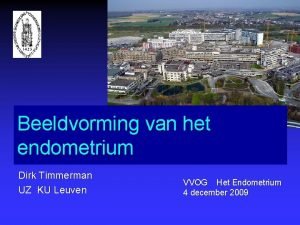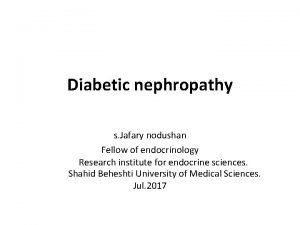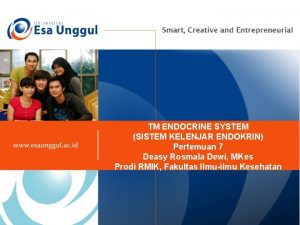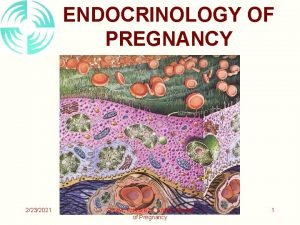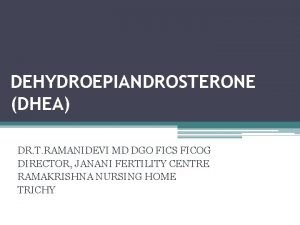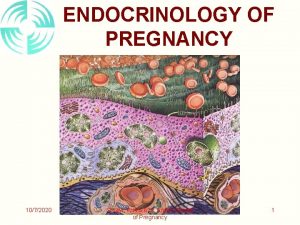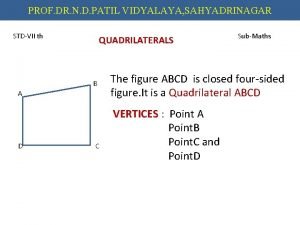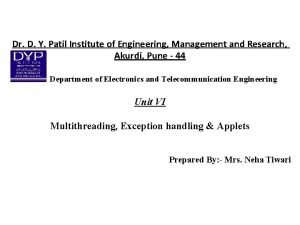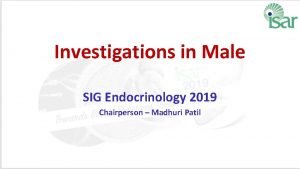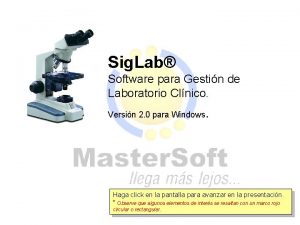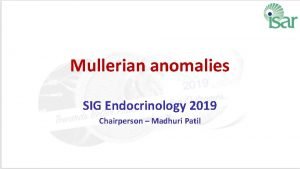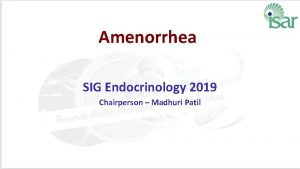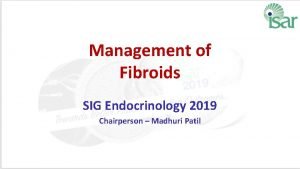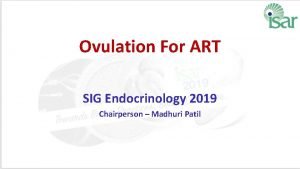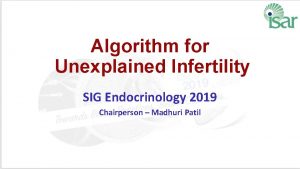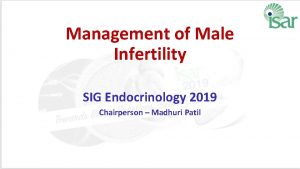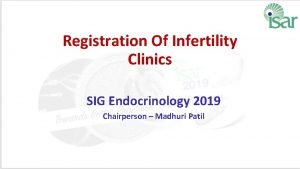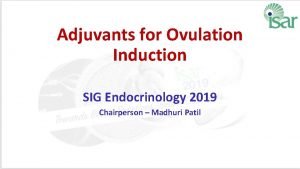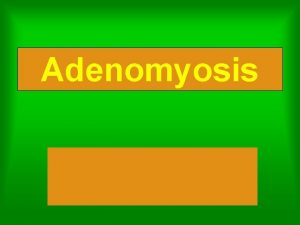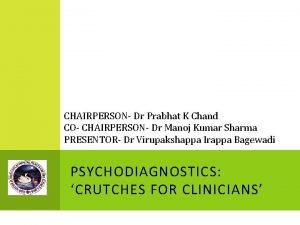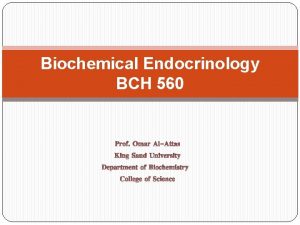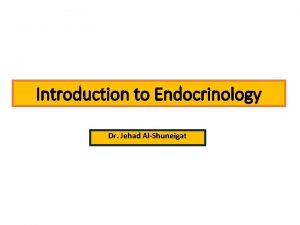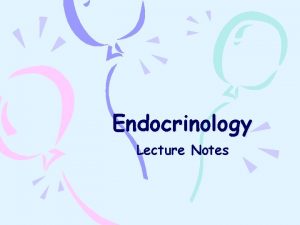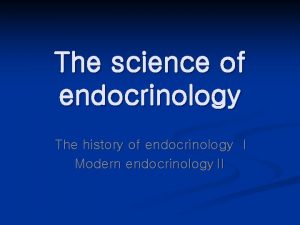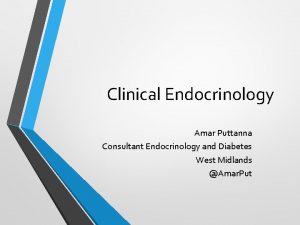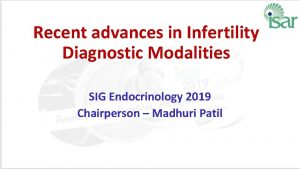Adenomyosis SIG Endocrinology 2019 Chairperson Madhuri Patil Adenomyosis
































- Slides: 32

Adenomyosis SIG Endocrinology 2019 Chairperson – Madhuri Patil

Adenomyosis Presence of endometrial glands and stroma deep within the myometrium (>2. 5 mm from EJZ) It is a myoproliferative disease of the inner myometrium and is further characterized by an altered local paracrine and immune microenvironment Results in local inflammation and proliferation of basal endometrium into the uterine wall Prevalence ranging from 8 to 27% Association between pelvic endometriosis and adenomyosis 54% (de Souza et al, 1995) to 79 - 90% (Kuntz et al, 2005) (de Souza et al. , 1995; Kunz et al. , 2005, 2007; Kissler et al. , 2008), Kunz et al. (2007)

Etiology of Adenomyosis Trauma by chronic peristalsis and hyper peristalsis auto traumatization From the bone marrow stem cells (displaced through the vasculature Invagination of the basalis along the myometrial lymphatic system Invagination of the deep basal part of endometrium in the myometrium (estrogen dependent‐ promotes the process) Originates from embryological pluripotential mullerian remnants

Adenomyosis Has possible association with early pregnancy loss subfertility menorrhagia dysmenorrhea pain

Characteristics To Be Used For Categorization Anatomical characteristics Histological characteristics • Uterine zone: outer myometrium, inner myometrium, junctional zone myometrium, endometrium • Location: anterior wall, posterior wall, fundus, lateral wall • Infiltration: depth of disease • Variant: cystic, predominantly grandular/muscular, atypical • Pattern – Diffuse, localized • Others? – Extra‐uterine lesions (endometriosis, adhesions etc)

Proposed Classification of Adenomyosis Proposed Classification JZ hyperplasia Criteria JZ thickness measuring images in women Adenomyosis JW thickness 8 mm but < 12 mm on T 2‐weighted 35 years. Partial or diffuse 12 mm; high‐signal intensity myometrial foci; involvement of the outer myometrium; < 1/3, < 2/3, >2/3 Adenomyoma Myometrial mass with indistinct margins of primarily low‐ signal intensity on all MR sequences. Retrocervical, retrovaginal, fallopian tube and bladder types Gordts et al, RBM Online, 17: 244‐ 248, 2009

Surgical/histological classification of adenomyosis Diffuse adenomyosis 1. Smooth muscle hyperplasia with ectopic endometrium (� junctional zone) 2. Micro‐dilated ectopic endometrial glands throughout hyperplastic myometrium Focal adenomyosis 1. Adenomyomas 2. Cystic adult adenomyosis 2 a. Juvenile cystic adenomyosis Polypoid adenomyosis Typical polypoid adenomyomas Atypical polypoid adenomyomas Special categories 1. Adenomyomas of endocervical type 2. Retroperitoneal adenomyosis 3. Rectovaginal endometriosis Grimbizis et al, Fertil Steril, 101: 472‐ 487, 2014

Subtype I: Direct endometrial invasion Disruption of the endometrial‐myometrial barrier Traumatic damage of the barrier (curettage) Disruption of the barrier during normal pregnancy by the trophoblastic invasion In nulliparous women other mechanisms could underlie to this disruption that could consequently affect implantation? Subtype II: Endometriotic invasion from the outside Pelvic endometriosis is the progenitor In the absence of inner junctional zone invasion is there any additional impact on implantation and fertility potential by adenomyosis or this is the result of endometriosis? Four subtypes of adenomyosis assessed by magnetic resonance imaging and their specification Subtype III: De novo metaplasia? What is the exact impact on fertility potential? Is there a correlation with size like myomas? Subtype IV: heterogeneous mixture of advanced stages of previous subtypes What is the impact on fertility potential? Kishi et al, Am J Obstet Gynecol, 2012

Pattern of disease Diffuse adenomyosis Diffuse - Mild Diffuse -Severe

Pattern of disease Focal adenomyosis Adenomyoma

Adenomyosis and Reproduction Proposed Staging Stage 0 Stage 1 solitary junctional zone hyperplasia without infiltration myometrium a focal thickening of junctional zone <20 mm b focal thickening of junctional zone >20 mm Stage 2 a: diffuse adenomyosis with less than 1/3 of myometrium involved b: diffuse adenomyosis with more than 1/3 of myometrium involved Stage 3 uterine adenomyosis and extra‐uterine localization (RV, bladder)

Diagnosis USG – 2 D and 3 D MRI heterogeneous myometrial area ‐ (88% sensitivity; 75% accuracy JZ >12 mm globular asymmetric uterus Focal thickening of JZ irregular cystic spaces ‐ (98% specificity; 78% accuracy) Adenomyotic nodule myometrial linear striations with poor definition of endometrial myometrial junction myometrial anterior posterior asymmetry and thickening of anterior and posterior myometrial wall and increased or decreased echogenecity On 3 D‐TVS, the best markers were JZ difference >4 mm and JZ infiltration and distortion (both 88% sensitivity; 85% and 82% accuracy, respectively

Spectrum of MRI findings and correlation with histology

Histopathology Targeted biopsy Zone 1 – Myometrium seen as homogenous structure Glandular extension > 2. 5 mm below the endometrial – myometrial interface Endometrial glands and stroma within myometrium Hyperplastic smooth muscle cells

At hysteroscopy subtle lesions may be diagnostic of adenomyosis Strawberry pattern Localized mucosal elevation Hypervascularisation Endometrial defects

Adenomyosis‐ Detrimental effect on infertility treatment Outcome Chronic inflammation Altered function of HOX A 10 gen (Tremellen and Russell‐ 2012) Abnormal intra‐ myometrial metabolism Dysregulation myometrial architecture Over expression of endometrial c. P 450 Dysperistalsis (Kissler et al‐ 2006) (Brosens et al‐ 2004) Alterations of adhesion molecules, cell proliferation, apoptosis, free radical metabolism Benagiano et al‐ 2012, 2013)

Junctional zone abnormalities due to adenomyosis associated with lower Implantation rates Excessive inner myometrium contractions have been shown to reduce implantation rates in both spontaneous and stimulated cycles Inverse correlation between the frequency of uterine peristalsis on the day of embryo transfer and pregnancy outcome. High-frequency endometrial waves on the day of embryo transfer appear to affect the IVF-ET outcome in a negative manner, possibly by expelling embryos from the uterine cavity

IVF/ET Outcomes In Relation To Myometrial Thickness Myometrial thickening of more than 2. 50 cm exerts overall adverse effects on IVF‐ET outcomes Even with mild thickening (2. 00– 2. 49 cm), the presence of sonographic findings suggestive of adenomyosis is associated with adverse outcomes of IVF‐ET Hyun Sik Youm et al J Assit Reprod Genet. 2011 Sept 24

Management of Adenomyosis intrauterine insertion of danazol- or Levonorgestrel loaded devices Gn. RH agonist therapy laparoscopic partial resection with uterine artery occlusion adenomyomectomy combination therapy of conservative surgery with a Gn. RH agonist high intensity focused USG uterine artery embolization

Treatment options in patients with adenomyosis Non‐surgical medical and/or interventional • Hormonal treatment: Gn. RH‐a / LNG‐IUS • Uterine artery embolization • Magnetic Resonance guided Focused Ultrasound Surgery (MRg. FUS) Uterus sparing surgical treatment • Adenomyomectomy (laparoscopic or hysteroscopic)

Hormonal treatment adenomyosis: Rationale Adenomyosis is an estrogen dependent disease developed during reproductive life period and suppressed with menopause Medical treatment is based on the disease’s hormonal dependency The effect of medical treatment is transient regressing disease process only during therapy Recognized approaches are Systemic hormonal treatment: Gn. RH‐a / dienogest (? ) Local hormonal treatment: LNG‐IUS or Dan IUS Fedele et al, Best Pract Res Clin Obstet Gynecol, 22: 333‐ 339, 2008 Petraglia et al, Best Pract Res Clin Obstet Gynecol, 22: 235‐ 249, 2008

Surgical treatment adenomyosis: Rationale Excision or destruction of the diseased tissue with concomitant maintenance of the healthy myometriun is the goal of any surgical conservative treatment Adenomyosis/adenomyomas infiltrates myometrium Adenomyomectomy is always associated with concomitant removal of some amount of myometrial tissue Fedele et al, Best Pract Res Clin Obstet Gynecol, 22: 333‐ 339, 2008 Petraglia et al, Best Pract Res Clin Obstet Gynecol, 22: 235‐ 249, 2008

Classification Of Uterus Sparing Techniques And Their Variants Excisional Techniques Grimbizis et al, Fertil Steril, 101: 472‐ 487, 2014

Principles of conservative excisional surgery: Pre‐operative Preoperative mapping of the lesion with MRI is necessary; use of the MRI images as a guide for lesion’s excision in the OR Pretreatment with Gn. RH‐a should be avoided; it worsens the recognition of the adenomyotic lesion’s borders Preparation for intraoperative use of imaging technique; consider TVS or even laparoscopic probes Plan for intraoperative use of accessory instruments: uterine manipulators, methylene blue or indigo‐carmine

Principles of conservative excisional surgery: intra‐ operative Bleeding prevention and control; consider the use of vasoconstricting agents (vasopressin or epinephrine) Bleeding prevention and control; consider mechanical with transient occlusion of the uterine arteries (tourniquet, clips) Electrosurgery could be used for incision, sharp dissection of the adenomyotic lesions and bleeding control Meticulous technique, proper hydration of tissues and avoida‐ nce of foreign bodies in cases of laparotomy are necessary

Principles of conservative excisional surgery: intra‐ operative Sub‐serous layer 5 to 10 mm could be usually preserved during lesion excision since it is rarely affected by the disease The potential opening of the endometrial cavity could be checked with the injection of methylene blue or indigo‐carmine Absorbable braided/coated polyglactin sutures should be used; 3/0 or 2/0 for the endometrium and 0 or 1 for the myometrium Thorough closure of all the defect in order to minimize the risk of hematoma is necessary

Combination Of Conservative Surgery With Gn. RH Agonist/Danazol Eight studies evaluating conservative surgery with or without Gn. RH agonist Four of these were case series, and four were case reports. The pooled live birth rate after this mode of treatment was 88. 2% Six of these studies used Gn. RHa post-operatively and the other two used danazol Comparative live birth rates following conservative surgery versus Gn. RH agonist alone were 32. 14 versus 8%, respectively Odds of having a live birth with conservative surgery+agonist was 3. 91 (95% CI, 1. 06, 14. 43) compared with that with Gn. RH agonist alone

Surgery can result in Reduction in myometrial capacity Abortion Increased incidence C‐ section uterine rupture premature labour

Other Modalities of Treatment for Adenomyosis Uterine artery embolization High intensity focused USG UAE likely to be effective in focal adenomyosis and adenomyoma Recurrence rate at end of 2‐ 3 years is 40% in diffuse adenomyosis A single published study evaluated the effectiveness of uterine artery embolization After a follow‐up of 35 months a live birth rate of 83. 3% (five of six patients) was reported (Kim et al. 2005) Embospheres® Microspheres Polyvinyl Alcohol Particles High intensity acoustic beam that is precisely focused on a target area with MRI guidance to cause thermal coagulation Heat ablation destroys normal endometrium Rabinovici et al. , 2006

Take home Message ------- Although adenomyosis can be diagnosed during various investigations for infertility, its significance is uncertain with respect to infertility or outcomes after ART MRI and USG are non-invasive diagnostic tests with a similar accuracy in diagnosing adenomyosis but need standardization Adenomyosis is present in a high proportion of women with subfertility, particularly those with endometriosis and or symptoms suggestive menorrhagia and dysmenorrhoea

Take home Message ------- Adenomyosis lowers implatation rates and increase abortion rates. Heterogenecity of results are due to the different ovarian stimulation protocols used and to the absence of an exact description of the adenomyotic lesion, because no standardized classification. Possible beneficial effect of hormonal suppression

Take home Message ------There are no fertility-sparing treatments of proven effectiveness Various treatments that have been advocated need testing in large, well-designed, adequately powered studies More studies are needed to determine its implications on reproductive outcomes, with and without treatment Decreased fertility through involvement of junctional zone Cyto reductive treatment results in amelioration of fertility
 Yashraj patil dy patil
Yashraj patil dy patil Diffuse adenomyosis
Diffuse adenomyosis Park nicollet pediatric endocrinology
Park nicollet pediatric endocrinology Endocrinology
Endocrinology Istilah medis dalam sistem endokrin
Istilah medis dalam sistem endokrin 2232021
2232021 Reproductive biology and endocrinology
Reproductive biology and endocrinology Endocrinology of pregnancy
Endocrinology of pregnancy Reproductive endocrinology near campbell
Reproductive endocrinology near campbell Bryneven primary school
Bryneven primary school Zone chairperson report
Zone chairperson report Lions club marketing communications chairperson
Lions club marketing communications chairperson Zone chairperson
Zone chairperson Sgb chairperson report
Sgb chairperson report Ncf curriculum framework 2005
Ncf curriculum framework 2005 Lions club zone chairperson
Lions club zone chairperson Kari amruta patil
Kari amruta patil Sudarshan patil dysp
Sudarshan patil dysp Rajashri patil md
Rajashri patil md Partes del laringoscopio
Partes del laringoscopio Yadravkar wada
Yadravkar wada Prof n d patil
Prof n d patil Karmaveer bhaurao patil drawing
Karmaveer bhaurao patil drawing Shamrao patil yadravkar
Shamrao patil yadravkar Iwak lele duwe patil
Iwak lele duwe patil Funny patil
Funny patil Zero error by mahesh patil
Zero error by mahesh patil Male sig
Male sig Sig lab
Sig lab Pengetahuan dasar pemetaan pengindraan jauh dan sig
Pengetahuan dasar pemetaan pengindraan jauh dan sig Manfaat sig dalam bidang pendidikan
Manfaat sig dalam bidang pendidikan Sig fig tutorial
Sig fig tutorial Significant figures rules
Significant figures rules

